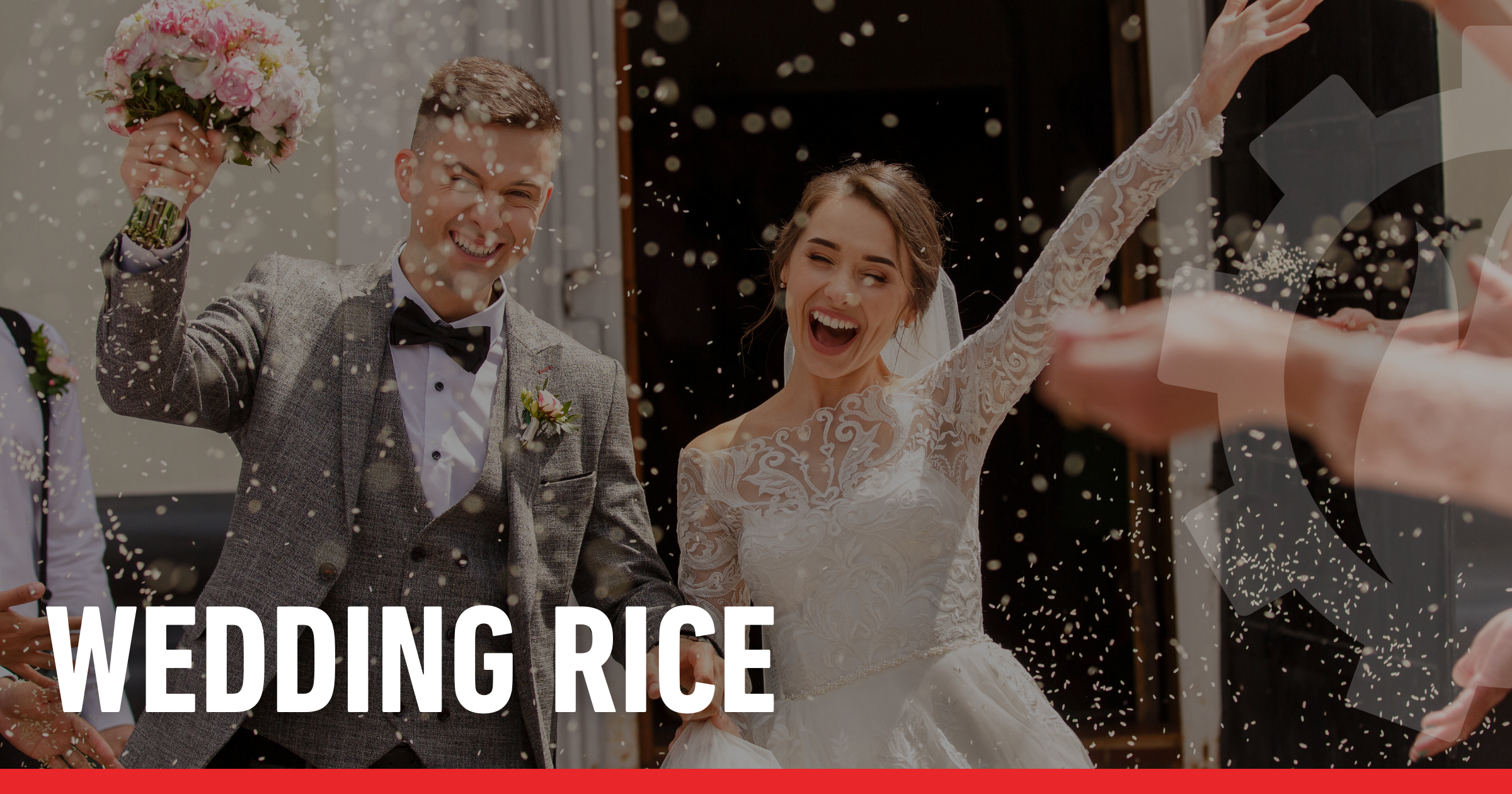Wedding Rice & Rituals
If you’ve been to a few weddings lately, you probably know the flow hasn’t changed much: the march down the aisle, the vows, the rings, the kiss, the grand exit, and then the party, with a few time-honored traditions woven in. One of the most iconic rituals is showering the newlyweds with rice as they make their way down the aisle or into the awaiting vehicle. It’s a festive moment and makes for a great photo. But have you ever stopped to wonder where this tradition comes from? What may seem like a simple gesture is actually rooted in centuries of symbolism. That tiny grain of rice carries big meaning as the practice shows up in different forms across cultures and eras. Here’s some info on how rice-throwing became a wedding classic, and why grain-tossing rituals have endured through the centuries, and some other traditions around the ceremony. Enjoy, and thanks to Google, YouTube, whitehousehistory.org, brides.com for the info. Enjoy!

Get you in the wedding mood music!
Grains Were Linked to Ancient Fertility
In ancient agricultural societies, fertility wasn’t just desirable — it was vital to both survival and spiritual life. Ensuring crops grew, families expanded, and communities thrived depended on a close relationship with the natural world. People believed that calling on the natural crop cycles of planting, harvest, and renewal during a marriage could help ensure the couple’s future would be equally productive.
Among early cultures such as the Celts and Mesopotamians, native grains, including wheat and barley, were considered sacred symbols of abundance and growth.
Greeks and Romans Tossed Grains To Call on the Gods
As civilizations became more organized, these agricultural customs became woven into more formal religious traditions. In ancient Rome, guests often tossed wheat or barley at weddings in honor of Ceres, the goddess of agriculture, fertility, and family. Roman brides sometimes wore crowns or garlands of wheat in their hair, highlighting their expected role in continuing the family line. Greek ceremonies included similar practices, invoking Demeter, the goddess of the harvest, through offerings of grain. In both cultures, grains were offered not only for luck but also as part of a broader worldview that linked successful marriages with divine blessing and societal stability.
Rice Played a Sacred Role in Ancient Asian Ceremonies
While wheat and barley featured prominently in the West, rice took on sacred importance in many Asian cultures. In China, rice has symbolized life, wealth, and harmony with nature for thousands of years. Historically, rice featured prominently in ancestral offerings and seasonal rites, and its association with fertility and family continuity made it a natural part of wedding customs. In India, rice has been integral to Hindu wedding rituals for thousands of years.
One of the most meaningful customs is Akshata, in which whole grains of rice, often dyed with turmeric or vermilion, are showered on the bride and groom as a symbol of abundance, fertility, and divine favor. Across Southeast Asia, similar rituals appear, many tied to local fertility goddesses, such as Dewi Sri in Indonesia.
Rice Was Introduced to Europe Through Trade
Despite its importance elsewhere, rice was largely unfamiliar in Europe until it began arriving via trade routes from Asia and the Middle East. By the Middle Ages, it had made its way into European markets, thanks to expanding contact with the Islamic world in places such as Spain and Sicily, and increased trade spurred by the Crusades. Its symbolism dovetailed neatly with older European traditions. Long before rice arrived, rural communities used native grains such as wheat, oats, and barley in wedding rites to bless the couple with prosperity and children. By the 19th century, throwing rice at weddings had become a widespread and beloved tradition in Western cultures.
How the Rice-Throwing Ritual Has Changed
In recent decades, the tradition of throwing rice has shifted as couples opt for alternatives that are either more “environmentally friendly” or better suited to specific venues. Today, it’s not uncommon to see guests showering newlyweds with dried flower petals, birdseed, bubbles, or biodegradable confetti
Some venues discourage the use of rice because of cleanup concerns or the widespread (but incorrect) belief that it harms birds. That myth, which gained traction in the 1980s, claimed that birds would eat the rice, which would swell in their stomachs and cause injury or death. However, wildlife experts and ornithologists have since debunked that idea. Birds can digest uncooked rice just fine – after all, it’s a staple food for many wild species around the world. I actually love tossing rice at newlyweds!
Other traditions include:
The White Wedding Dress
The tradition of the white wedding dress is credited to Queen Victoria in 1840 when she wore a white gown to marry Prince Albert. At the time, white symbolized wealth rather than purity, as it was difficult to clean and maintain. Over time, the color took on associations with innocence and virginity, especially in Western Christian cultures. Today, brides often wear white out of tradition, even if the symbolic meanings have faded.
Something Old, Something New, Something Borrowed, Something Blue
This charming rhyme is a Victorian-era custom meant to bring good fortune to the bride. Each item represents a different hope for the marriage:
- “Something Old” symbolizes continuity and a connection to the bride’s past.
- “Something New” represents optimism for the future.
- “Something Borrowed” is meant to carry happiness from a happily married friend or family member.
- “Something Blue” stands for fidelity and love, as blue was traditionally associated with the Virgin Mary and purity.
The Wedding Veil
The veil is one of the oldest wedding traditions, tracing back to ancient Rome, where it was believed to protect the bride from evil spirits and jealous eyes. In some cultures, veils symbolized modesty or obedience, especially in religious settings. Today, veils are more of a fashion accessory, but they still add a sense of mystery and ceremony to the bride’s entrance.
Walking Down the Aisle with a Father
This custom originates from a time when daughters were considered the property of their fathers, and marriage was seen as a transaction (so different today!) Walking the bride down the aisle symbolized the father “giving away” his daughter to the groom. While the ownership aspect has faded, many still view this moment as a touching symbol of support, love, and family unity. THIS IS MY FAVORITE TRADITION!
The Ring Exchange
The wedding ring tradition dates back thousands of years, with early examples found in ancient Egypt. The circle represents eternity, and the ring’s placement on the left ring finger stems from the belief that a vein – vena amoris – ran directly from that finger to the heart. Today, the exchange of rings is a universal symbol of commitment and enduring love.
Tossing the Bouquet
This custom originated in medieval England, where guests would try to rip off pieces of the bride’s gown or flowers for good luck. To escape the grabbing hands, the bride would toss her bouquet and run. Over time, this became a playful tradition where the single woman who catches the bouquet is said to be the next to marry.
Cutting the Wedding Cake
Originally, wedding cakes were broken over the bride’s head in Roman times (can you imagine???) to symbolize fertility. Today, couples cut the cake together to symbolize partnership and feed each other as a gesture of mutual care.
The First Dance
The first dance symbolizes the couple’s first act of unity as husband and wife. Historically, in royal courts, the first dance was performed by the guest of honor. Over time, it evolved into a romantic and often choreographed moment where the couple takes the floor while guests look on, followed by everyone joining in to celebrate.
Breaking the Glass (Jewish Weddings)
At the end of many Jewish wedding ceremonies, the groom (and sometimes the bride) breaks a glass underfoot. This serves as a solemn reminder of the destruction of the Temple in Jerusalem and the fragility of human relationships. Guests shout “Mazel tov!”, wishing joy and congratulations. It’s a moment filled with deep spiritual symbolism and communal celebration.
The Dollar Dance (Money Dance)
Popular in many Eastern European, Filipino, and Latin American cultures, the money dance involves guests paying (with bills pinned to clothing or placed in a box) to dance with the bride or groom. This festive custom is a practical way to financially support the newlyweds and is usually accompanied by fun music and laughter.
Carrying the Bride Over the Threshold
This tradition dates back to ancient Rome, where it was believed that evil spirits lurked at doorways. Carrying the bride into the home protected her from being cursed. In medieval Europe, it also ensured that the bride didn’t appear too eager to lose her virginity. Today, it’s often done playfully and symbolically, marking the start of married life together.
Wearing a Garter / Garter Toss
The garter toss is a companion to the bouquet toss and stems from the belief that possessing a piece of the bride’s clothing brought good luck. The groom removes the garter from the bride’s leg (sometimes a bit suggestively) and tosses it to the group of single men. The man who catches it is said to be the next to marry … or at least next to embarrass himself on the dance floor.
How did you do on last week’s logo contest?
Check out our logo guide for the “Let’s Stay Curious” post here!






Leave a Reply
Want to join the discussion?Feel free to contribute!